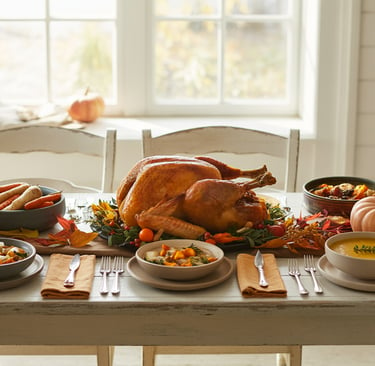Fall Food Safety: Keep Your Family Safe This Season
As the crisp air of autumn settles in, our routines shift-kids head back to school, sports seasons kick off, holidays creep in, and takeout becomes a tempting time-saver. But what doesn’t change? The need for smart food safety practices. In fact, fall brings unique risks and scenarios where foodborne illness can sneak in unnoticed. That’s why it’s essential to understand how to handle food safely in every situation this season. Here’s your guide to navigating fall food safety, with practical advice and simple steps that will help protect your family from foodborne bacteria!
8/2/20253 min read


Back to School: Safe Lunches for Growing Minds
Packing school lunches might feel routine, but don’t let safety take a back seat. Children are particularly vulnerable to foodborne illness, and their lunches often sit for hours before being eaten. Use these key tips to keep your child’s lunch both nutritious and safe:
Use an insulated lunch bag with a frozen gel pack to keep cold items like yogurt, deli meat, and cut fruit safe.
Hot foods like soup or chili? Store them in a preheated thermos to keep them at a safe temperature (140°F / 60°C or above).
Wash fruits and veggies thoroughly-even if they’re going to be peeled.
Include pre-packaged utensils and napkins if possible and teach your child to wash hands or use hand sanitizer before eating.
Tip: Keep a checklist on the fridge to remind yourself and your child of these daily food safety habits.
Game Day Ready: Defend Against BACTERIA!
Football season is more than touchdowns and snacks-it’s a major opportunity for food safety to go wrong. Tailgating and party spreads often involve buffet-style setups where food sits out too long, or where raw and cooked items mingle dangerously.
Protect your guests and yourself by:
Keeping raw meat, poultry, and seafood separate from ready-to-eat foods.
Using a food thermometer to check that burger, chicken wings, and sausages are fully cooked:
Ground beef: 160°F / 71°C
Chicken: 165°F / 74°C
Pork: 145°F / 63°C (with a 3-minute rest)
Refrigerating leftovers within two hours (or one hour if the game is outside in temps above 90°F / 32°C).
Keeping cold foods cold with coolers, ice packs, or nesting dishes in bowls of ice.
Tip: When in doubt, throw it out. Bacteria multiply quickly in food left in the danger zone (40°F–140°F / 4°C–60°C).
Halloween Food Safety: Avoid the Invisible Monsters
Halloween should be full of treats-not foodborne tricks. From classroom parties to home-baked snacks and trick-or-treat loot, there are plenty of chances for invisible germs to sneak in. Keep the season safe with these food safety reminders:
Inspect all candy before your child eats it. Discard anything that is unwrapped, damaged, or looks suspicious.
Avoid homemade treats received from strangers unless you personally know the source.
If you’re baking Halloween cookies or cupcakes, don’t taste raw dough or batter that contains eggs, or flour-both can harbour dangerous bacteria.
Wash hands before and after preparing or eating Halloween snacks, especially when kids are sharing bowls or handling lots of packaging.
Tip: Set aside a clean bowl for "approved" candy and keep it separate from the uninspected pile.
Takeout Sanity: Safety That Travels
Busy fall evenings often mean grabbing takeout to keep things simple. But takeout food still requires careful handling to prevent foodborne illness:
Pick up hot and cold foods last while running errands to reduce time spent in the temperature danger zone.
Eat hot food immediately or keep it warm (140°F / 60°C or above) until you're ready to eat.
Store leftovers promptly. Don’t let them sit out for more than 2 hours (1 hour if it’s warm in the car or home-above 90°F / 32°C).
Reheat leftovers to 165°F / 74°C, even if they came from a restaurant.
Use shallow containers for quicker cooling and better storage.
Tip: Label and date leftovers in the fridge. Most should be eaten within 3 to 4 days.
Looking Ahead: Fall Into Good Habits Now
Fall is a time of change and transition-which makes it the perfect time to reinforce food safety basics. As we prepare for colder weather and the busy holiday season, small daily habits make a big difference:
Always wash hands with soap and water for at least 20 seconds before handling food.
Keep raw and cooked foods separate during storage and prep.
Use a food thermometer regularly-don’t rely on guesswork.
Chill leftovers quickly and store them safely.
Practicing food safety doesn’t have to be complicated. With just a few smart steps, you can prevent illness and keep your family safe through every season.
Food safety is for everyone, every day-but especially during the busy, cozy, chaotic season that is fall. Whether you're managing school lunches, tailgates, trick-or-treating, or takeout, remember you can protect every meal with a little planning and a lot of care.
Stay safe, stay full, and stay well.
Join us on Pinterest
letstalk@lorybs.com
© 2025. All rights reserved.
